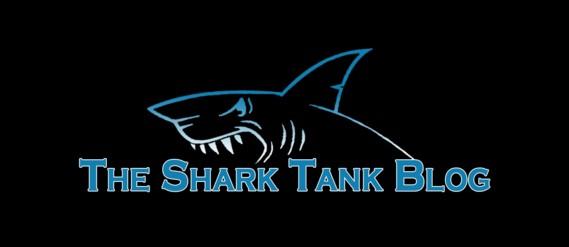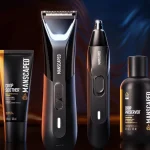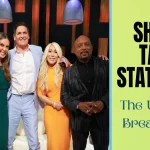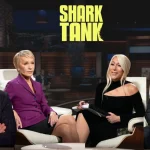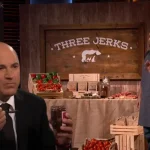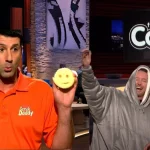Beyond the Tank Episode 109
 Beyond the Tank episode 109 aired Tuesday, April 19. Three past Shark Tank entrepreneurs got an in-depth update on their trials and tribulations since first appearing on the show. In Beyond the Tank episode 109, season five’s Hamboards, who partnered with Robert for a $30K investment, shows how they’ve grown since jumping in the tank. The Original Runner Company owner, Julie Goldman didn’t get a deal when she appeared in season two, but after following up with Barbara Corcoran a few years later, she ended up snagging a Shark anyway. In season four, Kevin and Robert invested in Ruck Pack, an energy drink made by veterans.
Beyond the Tank episode 109 aired Tuesday, April 19. Three past Shark Tank entrepreneurs got an in-depth update on their trials and tribulations since first appearing on the show. In Beyond the Tank episode 109, season five’s Hamboards, who partnered with Robert for a $30K investment, shows how they’ve grown since jumping in the tank. The Original Runner Company owner, Julie Goldman didn’t get a deal when she appeared in season two, but after following up with Barbara Corcoran a few years later, she ended up snagging a Shark anyway. In season four, Kevin and Robert invested in Ruck Pack, an energy drink made by veterans.
What have these companies been up to since partnering with a Shark? Find out on Beyond the Tank!
Beyond the Tank Episode 208 Featured Sharks
- Investor – Robert Herjavec
- Investor – Barbara Corcoran
- Investor – Kevin O’Leary
Beyond the Tank Episode 208 Entrepreneurs
- Company – Hamboards
- Company – Original Runner Company
- Company – Ruck Pack
Beyond the Tank Episode 208 Recap
Hamboards
Pete Hamborg came to Shark Tank in season 5 with his product, Hamboards. The skateboards replicate the feeling of surfing. He, his son Gus, and his cousin Donnie were able to reach a deal with Robert Herjavec for $30,000 in exchange for 30% equity.
“I invested in Hamboards,” Robert recalls, “Because this is a beautiful product. This is a lifestyle. It’s incredibly well made, the colors are great. It oozes California sexy.”
The Shark Tank effect overtook Hamboards like a tidal wave. “It wasn’t our intention to start a business that would expand to the level that it’s at right now. We’re playing in a league that’s above and beyond what we should be playing at, and that’s overwhelming at times,” relates Pete.
Pete’s been a full-time fire fighter for 30 years. He can’t give up his job, because the profits are being plowed back into Hamboards. He’s feeling overwhelmed by the success of the business. His five sons are investing time and effort into the business. One son is working full-time and has a baby on the way.
“I didn’t know how hard it would be to run a business,” admits Pete. “Not only have my sons had to work hard to keep Hamboards production alive, they actually had to help me pay the bills with the lifeguard money they earned over the summer. As a dad, that puts the realm of what happens with this company at a completely other level. I want Hamboards to grow into a legacy brand; something that honors their sacrifice.”
Pete’s determination to grow Hamboards has kept the business afloat, but Robert wants to talk about marketing. The first thing Robert notices when he arrives for a meeting is the new tee-shirts that the boys have begun selling on the website. The shirts are selling well.
“I don’t think you’re as much in the board business,” says Robert. “As you are in the lifestyle business.” He compares Hamboards to Ferrari. The car company, recognizing that “not everyone can afford a Ferrari, embraced the popularity of their brand and started selling tee-shirts. “The shirts are now 36% of their business,” explains Robert. Since the profit margins are so high on the tee shirts, Robert loves the idea.
Since appearing on Shark Tank, total sales have gone past $1 million. The number seems impressive, but in the past year the sales were $450 thousand. The break-even point is between $750-850 thousand. With Hamboards, 85% of sales are coming from 4 of the 12 products. Robert points out the necessity of making some serious changes to keep Hamboards alive. Pete is determined to keep Hamboards alive.
“The culture of any company is determined by the CEO. And when you have someone like Pete, that is the culture,” says Robert.
Robert wants to remove a few of the products that aren’t bringing in the profit. Pete was reluctant to accept the tee shirts. Robert tells them that the tee shirts are the “French fries to the hamburger.”
He advises them to pare down the offering to the 8 products that are making money and work to reduce costs by at least 10%. By doing so, Hamboards can become profitable. “I don’t believe you’re ever going to be on a fast burn, “ says Robert, “But you’re going to be on a steady climb, and that’s what you want.”
Two months after meeting with Robert, Hamboards has streamlined their inventory and have entered a surfing retail shop, Huntington Surf and Sport. They hope to move into other retail locations in the future.
“I am confident,” says Pete, “That, with Robert’s help and advice, and our hard work, we can realize our dream of turning Hamboards into a family legacy.”
The Original Runner Company
Julie Goldman came to Shark Tank in Season 2.
“I went into the Tank as prepared as I possibly could be,” remembers Julie. “And being prepared with those answers made me feel very confident in my pitch. For other people, it may have made me come off as a little arrogant but to me, it was knowing my business inside and out and making sure I was presenting myself and my brand to the best of my ability.”
Julie’s straightforward manner didn’t float well in the Tank. She was already making solid sales to celebrities and other high-end clients, but wanted to go after the general retail market.
Kevin O’Leary was unimpressed. “You’ve got a fantastic business that makes phenomenal margins,” he told her in the Tank. “You’re capturing the high-end, and you want to go play in the toilet bowl weddings.”
One by one, the Sharks went out.
“I think that the reaction I got from the Sharks was because I am passionate about what I do, and maybe a little bit aggressive in defending it,” says Julie. “Maybe I should’ve been more humble, and that’s something I’m continually working on.”
All was not lost in the Tank for Julie. After the episode, she was approached by one of the largest craft stores in the industry. They wanted to put The Original Runner into their wedding line. Six months of negotiations, however, proved the Sharks right. Julie discovered that the margins in retail sales simply were not high enough to justify taking the deal. Julie was back to running The Original Runner Company on the same single-proprietor model she started out with, which limited her growth potential.
“Usually when an entrepreneur leaves the set,” says Barbara Corcoran, “They’re out of my mind right away if I haven’t invested in them. But with Julie, she haunted me. She weathered the most vicious balls-out Shark attack I’ve ever seen in the Tank.”
Barbara was intrigued. She’s decided to come and visit Julie. Barbara actually apologized to Julie for not standing up to the male Sharks when they came at Julie.
“I’ve been in so many situations when I was the only girl in a pack full of men. I know what it feels like, and it’s not easy,” says Barbara.
She offers to go over Julie’s profit and loss statements. Barbara’s impressed by the growth Julie’s sustained. She’s grown from $911,000 in sales to over $1 million. Barbara asks if Julie has considered going global with her production, but Julie explains that, as a small business, it’s difficult to make those connections. Manufacturing overseas would lower costs significantly.
Barbara recommends that Julie focuses on building her marketing efforts to vendors, who are her bread-and-butter. The large vendors making repeat orders are Julie’s main source of profit. Since she’s running the business herself, it’s difficult for Julie to do that.
“When I met Julie in the Tank, I didn’t think she needed help. She needs so much help,” says Barbara.
She offers to help Julie make the overseas contacts she needs. She also points out that Julie is spending too much time stuck with running the business while marketing doesn’t get enough attention. Barbara makes an offer to Julie. She will offer her contacts, her knowledge of personnel, and her resources to get Julie out marketing while qualified managers run the business at home. In return, once Barbara has doubled the sales every year for two years, she will take 25%, but if she’s unable to make the proposed profit margin, Julie will owe her nothing.
“This is a deal where everybody wins,” says Barbara. “Every small business wants an investor who puts money in. I’m not putting money in. I’m putting in something far more valuable. I’m putting my intelligence and my guidance to get her to build a huge business.”
Julie accepts, and lands her Shark investor. “Julie deserves a second chance, “ says Barbara. “She’s the kind of lady who always delivers, and that’s the kind of person I always want to be in business with- somebody who’s going to make me money.”
RuckPack Combat Nutrition
Rob Dyer came to Shark Tank in season 4. He landed a deal with Robert Herjavec and Kevin O’Leary for $150,000 in return for 20% equity.
“Rob’s product, RuckPack, was the first energy and protein drink I’ve ever tried that didn’t have caffeine in it. What I saw in the product was, it worked. It didn’t give me that sugar high. Also, this company’s all about serving the country, then serving the customer, too. I like that.”
Since going on Shark Tank, RuckPack entered the retail market and invaded 10,000 retail locations. The business has exploded, but Rob isn’t able to put 100% of his time into being a CEO, because his son has had serious health challenges. He brought in a CEO, who did some serious damage to the company’s bottom line. Now, Rob has a new CEO, someone he grew up with, and feels confident that the company is going in a good new direction.
Kevin is coming in for a meeting, and Rob and his new CEO, Jimmy, are preparing to present him with four new products they hope to launch in hopes of salvaging the company’s cash flow.
“I’m visiting RuckPack because I want to find out what’s happened through all the transitions and changes,” says Kevin. “Number one, we have new products. Number two, we have a new CEO. That’s a major concern. This is so much change in a short period of time. I need to take stock of where we are.”
Rob gives Kevin a tour of the warehouse and lab where RuckPack is made. Rob wants to put out the new product line in order to remain competitive, but cash flow is an issue because of the missteps from the previous CEO.
Kevin has some tough questions for Jimmy. He wants to know why he thinks he’s a CEO. Jimmy is knowledgeable and passionate about the product, but Kevin wants to know if he can take the company to the millions. RuckPack is trying to gain market share in a very competitive market.
“Of course I’m skeptical,” says Kevin, “Because we have a revolving door of CEOs.”
Jimmy and Rob present Kevin with the new products. He’s impressed with the improved flavor and new nutritional formulas.
Finally, Rob and Jimmy present Kevin with their idea of hiring veterans to go out and sell the product as commissioned salespeople. Kevin is impressed.
“This could be a fantastic new distribution strategy,” says Kevin. “It’s what this company needs… “This thing still has a heartbeat.”
With Kevin backing them, and Rob’s commitment to investing in the vet community, RuckPack has found its second wind.

